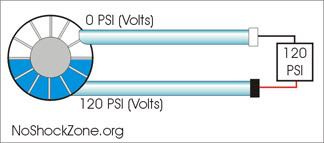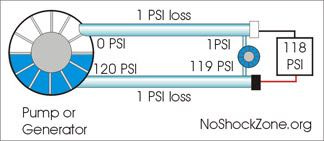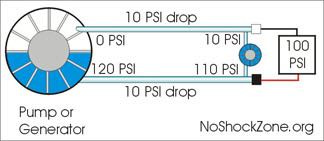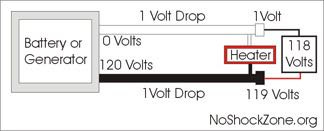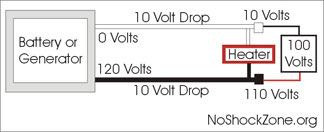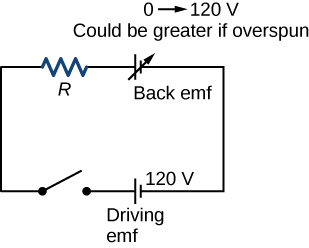Rumors and Innuendo
We’ve all heard about how hooking up an RV on too long or too skinny of an extension cord can force its appliances to run on 100 volts instead of the regular 120 volts, thereby burning out the motors or other components. But before we get into the reality of what happens to gear running on 100 volts rather then a full 120 volts, let’s figure out why this voltage drop thing happens in the first place.
What’s This Voltage Drop Thing?
If you look at the first illustration you’ll see a pump on your left that can supply 120 PSI (Pounds per Square Inch) of pressure, and two pipes heading to the right side. I’ve capped one pipe with a white stopper and the other with a black stopper so that no water can leak out. Because there’s no water flow, the pressure within each pipe will be equal to the pressure of the pump. The bottom pipe, which is hooked to the 120 PSI output of the pump, will have 120 PSI all along its length, while the top pipe, which drains back into the pump, will have 0 PSI along its entire length.
And you can imagine that it really doesn’t matter if that pipe is large or small in diameter. The pressure within each pipe will be equal throughout its length. I’ve added a differential pressure gauge to the far right of the illustration that shows there’s now 120 PSI difference between the two pipes, just like a voltmeter reads the voltage difference between its two probes. Note that no real work is being done; it’s just an equalized pressure system. This is exactly what happens to an electrical outlet in your home or RV. There’s electrical pressure (Voltage) but no current flow (Amperage) until you plug something into it.
Big Pipes Equal Small Pressure Loss
Now let’s make our pump do some work. We’ve added a small turbine to the right side of the drawing connecting the top pipe to the bottom pipe. The pressure of the water will cause a current to flow through that small turbine to power your blender making a frozen drink of your choice. But this isn’t a perfect world, and because there are rough spots inside of those big pipes, they offer resistance to the flow. This shows up as a loss of pressure that’s dependent on how long the pipes are and how many gallons per minute we expect them to carry. In this case we have really big pipes carrying the water to the little turbine, so the small amount of flow (current) required only causes a 1 PSI drop in pressure in each pipe. So when we put our pressure meter across the ends of the pipes at the caps, you’ll see that instead of a full 120 PSI of pressure, we only have 118 PSI. That’s an acceptable loss in this case since our little turbine is rated for pressures from 110 to 125 PSI and all is well.
Small Pipes Equal Big Pressure Loss
Imagine, however, what would happen if your plumber went cheap and installed really small feeder pipes to your turbine. Your pump would still be creating 120 PSI of pressure, but the current flow would be restricted by the too-small feeder pipes. Consequently, rather than losing just 1 PSI of pressure, you would now lose 10 PSI of pressure with the same current flow as before. Since the top of the turbine has 10 PSI of pressure holding it back, and the bottom of the turbine only has 110 PSI to begin with, there’s only 100 PSI difference in pressure to drive the little turbine. Our turbine needs at least 110 PSI to operate properly, so now it’s starved for pressure and won’t spin fast enough to do its job. This same effect of pressure loss would occur with larger pipes over very long distances. Therefore, if we made our pipes in the first illustration ten times longer, that 1 PSI of pressure loss would then become 10 PSI of pressure loss.
Big Wires
Now let’s substitute a battery or generator for the pump, and an electric heating element in our coffee maker for the turbine. Our generator is hooked up to the outlet powering the coffee maker’s resistive heating element with really big wires. And just as in the water example, there will be a certain amount of resistance to the current flow. This resistance to current (flow) is what causes voltage drops to occur. How much voltage drop is dependent on the type of metal inside the wire (typically copper, sometimes aluminum), the diameter of the wire (remember that 10-gauge wire is thicker than 14-gauge wire) and how long the run of wire happens to be (50 feet of wire will lose twice as much voltage as 25 feet of wire).
In our case we’ve run a sufficiently heavy wire from the generator to the outlet, so there’s maybe only 1 volt of electrical voltage (pressure) lost on the way through the black wire. But since it has to return through the white wire, there’s another 1 volt of loss on the return trip. That means the bottom side of the heater in our diagram is getting 119 volts of electrical pressure while the top side is getting 1 volt of electrical pressure. Since meters and heaters only care about the difference in voltage applied across their inputs, we’re providing 119 minus 1 which equals 118 volts. Since our little heater is rated for operation with voltages as low as 110 volts, we’re still in good shape and your coffee will be done in time.
Don’t go cheap!
But now we’ve cheaped out and installed far too skinny of an extension cord from the generator to the heater outlet. And any time we try to pull a significant current flow (let’s say, 10 amperes) down the skinny wire, there’s a lot of resistance to that flow, causing us to lose electrical pressure (voltage) just as we lost water pressure when using the pump with too-small of connecting pipes. In our generator illustration above there’s a 10-volt drop in the black wire and a matching 10-volt drop in the white wire. That leaves our heater with 110 volts on the bottom feed and 10 volts on the top feed. Again, our meter and heater element only care about the voltage differential applied to them, so it’s only working with 100 volts.
Bad Things
That should sound like a bad thing to you, and indeed it is. Two significant problems occur when you hook up your RV using a long or skinny (or both) extension cord. The first is that voltage drop causes the wire itself to heat up. And it can heat up to the point where it gets limp and catches on fire. The second problem is that your RV is only getting 100 volts of electrical voltage (pressure), when it really wants 120 volts.
You can reverse think this and realize that voltage drops only occur when you’re drawing significant amperage like an air conditioner or microwave. So while your electronic appliances such as a television may be operating properly with nothing else running in your RV, as soon as you turn on that roof air conditioner, you might see your television’s electronics starve for voltage and shut down. That’s certainly a problem if you’re watching an NCIS marathon.
Truth or Fiction: Low Voltage Kills Appliances
Well, low voltage affects only certain kinds of appliances and only under certain conditions. Resistive heaters like a coffee pot really don’t care if you feed them 120 volts or 110 volts or even 100 volts. They’ll just happily draw less current, which makes less wattage, which then takes longer to bring your water to a boil.
However, roof air conditioner compressors can refuse to start if you don’t provide them with sufficient voltage and current. That motor has to push a piston against a lot of Freon gas pressure, and if you don’t have enough push it’s going to stall. Plus, all AC or AC/DC induction motors, including your air conditioner compressor as well as hand tools like a circular saw, draw more amperage as the voltage drops.
Advanced Concept Alert
Here’s why…. AC and DC motors put out something called a Back EMF (Electro Magnetic Force) when running at their designed voltages. That’s because as these motors are spinning very fast they also act as generators putting out voltage in the reverse direction, and that reverse voltage (pressure) is what limits the current flowing through their brushes (the sparky things you see at the back of your drill).
However, if you starve an induction motor for voltage by using too small or too long of an extension cord, they won’t develop enough of this internal reverse voltage to limit the current flow through their own brushes. And that’s why you see lots of sparks fly from your power tools when running them on too long and too skinny extension cords. Reducing the voltage on a power tool or air conditioner compressor increases its amperage draw. You’ll kill the brushes in short order or overheat the motor unless you maintain full voltage at full current draw Heavy extension cords make for happy power tools.
Back to Basics
Also, of course, letting your voltage drop below 105 volts is bad for computers, sound systems and virtually everything else in your RV. And while it may not cause an actual meltdown in your appliances, it will reduce the performance of virtually everything not fed with sufficient voltage. Just like trying to start your car’s engine when the battery is nearly depleted will leave you with a grrrr, grrr, grrr and no start, making your appliances run from too low of a voltage, which will sometimes make them shut down or not boot up properly.
Quick Tips:
Long extension cords need to be heavier to reduce voltage drop.
Skinny extension cords have more voltage drop than thick extension cords.
Overloaded extension cords can overheat and catch fire.
Appliances generally don’t operate at full performance below 100 volts.
That’s all for today!
Okay everyone. Keep studying and be safe!



